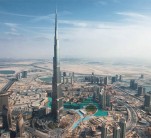Reliability Monitoring. Validating the Structural Behavior and Response of Burj Khalifa: The Development of Full Scale Structural Health Monitoring Programs

A new generation of tall and complex buildings reflects the latest developments in materials, design, sustainability, construction, and IT technologies. While design complexity can be managed through advances in structural analysis tools and software, ultimately the design of these buildings still relies on minimum code requirements that are yet to be validated in full scale. The involvement of the author in the design and construction of Burj Khalifa from inception until completion prompted the author to develop an extensive survey and real-time structural health monitoring program to validate the assumptions made during the development of the design and construction planning of the tower.
At 828m, Burj Khalifa is the world’s tallest man-made structure, composed of 162 floors above grade and 3 basement levels. The focus of this article is to provide a brief description of the structural and foundation system of the tower and to discuss the development of the survey and realtime Structural Health Monitoring Programs (SHMP). Correlation between the predicted and actual measured structural behavior will also be discussed, however, because of confidentiality the actual measured data cannot be disclosed at this time.
The SHMP included 1) monitoring the tower’s foundation system, 2) monitoring the foundation settlement, 3) measuring the column/wall strains and shortening during and after construction, 5) real time measuring of the tower lateral displacement and dynamic characteristics during construction, 6) measuring the building lateral movement under lateral loads (wind, seismic) during construction, 7) measuring the building displacements, accelerations, dynamic characteristics, and structural behavior during service life and 8) monitoring the Pinnacle dynamic behavior and fatigue characteristics.
While the SHMP developed for Burj Khalifa was a futuristic model at the time of its development, this field is constantly evolving and a new generation of SHM systems will emerge that uses the latest technological advances in devices and IT technologies.
Full content of this issue you can read here
The full version of the article can be read in our printed issue, also you can subscribe to the web-version of the magazine
 Author: Ahmad Abdelrazaq, Executive Vice President Head of Business Development/Technical
Author: Ahmad Abdelrazaq, Executive Vice President Head of Business Development/Technical
Proposal Division & Head of High-Rise & Complex Building Division of Samsung C&T Corporation


